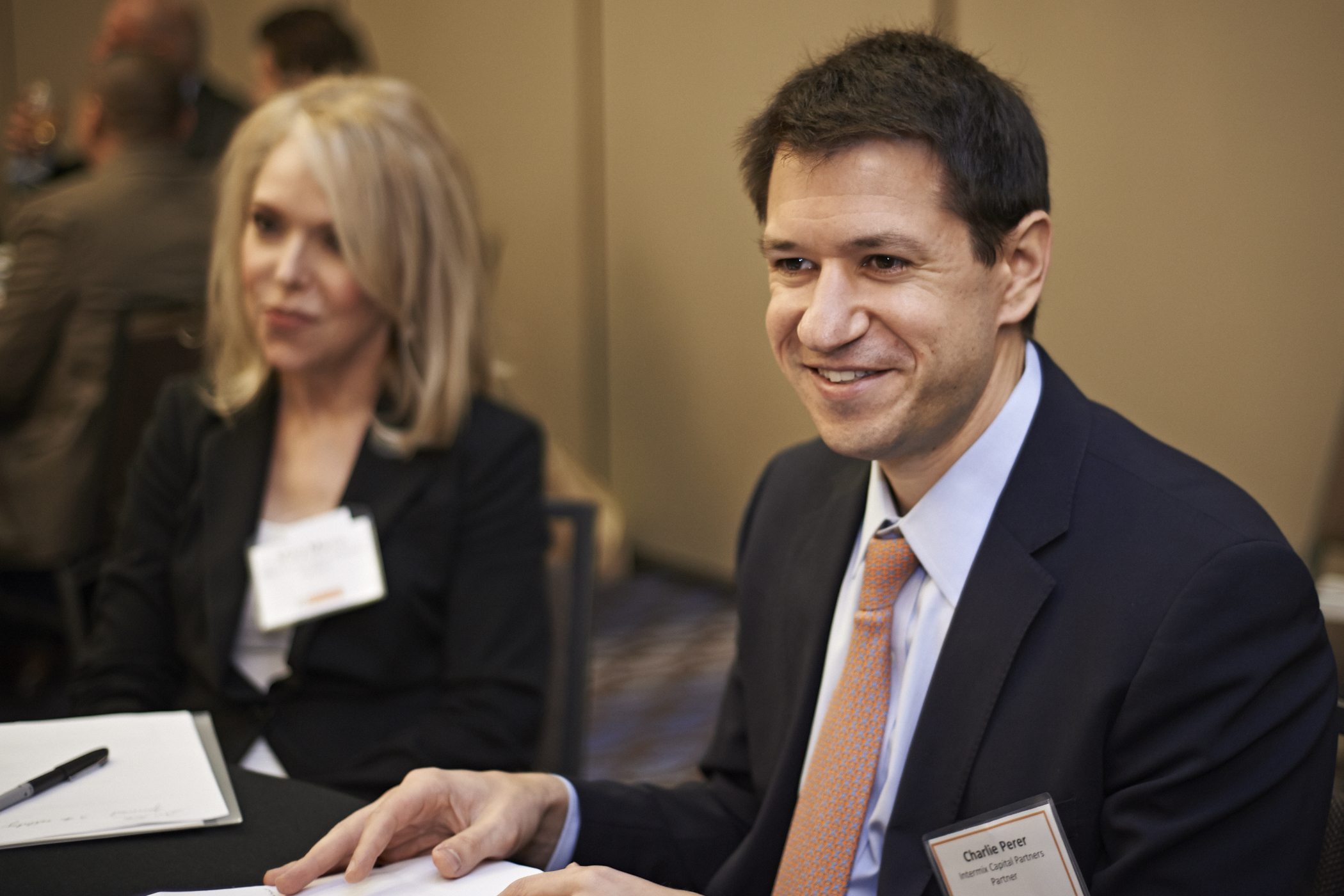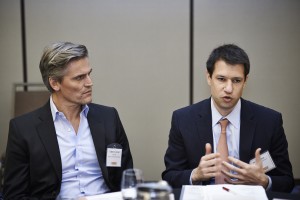December 3, 2013
BBR10 Thought Leader Q&A: Charlie Perer on “Financing for Emerging Beauty Companies”
December 3, 2013
BBR10 Thought Leader Q&A: Charlie Perer on “Financing for Emerging Beauty Companies”
From Wall Street to the Beauty Industry….Charlie Perer has seen it all.
Beauty Biz Roundtable 10 attendees looked forward to hearing Perer’s financial advice for beauty companies, based on his experience working with major brands like Stila and Sally Hershberger. Perer is a Partner at Intermix Capital Partners, a boutique private equity firm that partners with entrepreneurs and experienced executives to build industry leading branded consumer companies.

Please share 3 key points from your roundtable discussion on “Financing for Emerging Beauty Companies”:
- Time is one of the most important factors overlooked when raising capital. Great entrepreneurs value the benefit of time to perfect their product/brand, learn the process of selling-in, and more importantly, selling-through before looking to scale with capital. Most ventures fail when an entrepreneur is willing to risk time by investing money too quickly with the hope that a capital infusion can jump start sales.
- Category leadership/differentiation is of paramount importance when looking to raise capital. Strong leadership is a must when building and financing emerging brands, which often comes with challenges and complexities that arise when rapidly growing from sub-$10 million of sales to over $20 million.
- Distribution strategy is the foundation of any brand plan, so entrepreneurs need to be aware of the value and economics of myriad distribution channels. A strong point of difference in a capital efficient channel has the potential to create enormous value, but the opposite rings true when a brand tries to “swim upstream” and obtain distribution in a high barrier-to-entry channel with high fixed costs. The biggest success stories of the past decade were based on new distribution (specialty, TV or professional) at the early stages of the brand cycle. Most “exits” come from big acquirers purchasing emerging companies within their own channels of distribution, so they could create value overnight by expanding distribution through existing channels. Very rarely do you see companies successfully acquiring out of their own distribution network.
Please tell us about your career path/progression. The road to where you are now? How did you get started?
I started my career in investment banking in NYC. This provided a great learning experience to see how entrepreneurs built their businesses, and worked with Wall Street to obtain financing. Ultimately, I wanted to partner with entrepreneurs, so I moved to LA in 2002 to pursue my interest in working with emerging companies.
I got started by consulting for business owners, and quickly moved to advising and investing when appropriate. I started broad with respect to industries, but quickly realized that the consumer market was under-served. Many companies are caught between what is generally termed “venture capital” (early-stage companies usually with differentiation via technology), and “private equity”, (more mature/later stage companies). I came across many companies that did not have access to capital, or a trusted business adviser to help them plan for scaling back.
Why did you choose this career? Why the beauty industry?
I fell into beauty by accident by working on the acquisition of Stila by Estee Lauder in 2006. I ended up loving the beauty industry as all of the entrepreneurs I met were all genuine and highly talented. Successful entrepreneurs have a real vision and point-of-difference in the marketplace, based on a life-long career working with their respective clients whether it be a stylist, artist, or other beauty-related passion or profession. After the Stila transaction, I co-founded Sally Hershberger Professional Hair Care with Sally and a few other quality professionals, and at that point, I started to focus more on the beauty industry.
After getting Sally’s company off the ground, I founded Intermix Capital with Mark Stiller since we shared the same vision in providing capital and operations support to emerging companies. Fast forward several years later, and Mark is now an entrepreneur again running It Factor (a professional hair care line focused on reducing drying time), and I am still focused on investing and advising emerging companies.

Who/what are your biggest career influences?
1) Mark Stiller, Founder and CEO of It Factor professional hair care company, and former COO of Sexy Hair. Mark, along with Michael O’Rourke, built Sexy Hair into a global business. Mark taught me many things, and some of the most important lessons I’ve learned are: 1) the value of leadership/integrity, 2) the importance of being a first “mover” in your respective category, and continuing the fight to maintain the lead, and 3) the importance of team-building , since a company cannot become global without a strong organizational foundation.
2) Budd Taylor, former President of Smashbox. Budd was one of the most creative marketers I have ever met, and I was fortunate to meet him early on in my career. I always thought his approach to building brands was authentic, and that he really stayed true to the brand vision. He taught me to understand how a brand’s activities should center around the target customer’s lifestyle.
Who is today’s beauty consumer? How are they changing?
He/she is navigating through more clutter than ever, with less time and with more specific needs. Just look how merchandising has changed to fit his/her needs. We are continuing to see a generational change in terms of preferences and culture, with open-sell specialty formats dominating the market, and more retailers creating/providing proprietary brands. Most importantly, the concept of “omni-channel” is becoming mainstream with brands and retailers catering to the consumer’s desire to have products and service when they want and where they want. Rather than technology being the key driver, a unique experience and service remains critical.

BBR9 Thought Leader, Fabrice Croisé, sitting at Charlie Perer’s BBR10 roundtable
What do beauty professionals need to do to continue to connect/attract with today’s beauty consumer?
I think this is a great question with a timeless answer. The delivery mechanism may change how people consume, but content will always be king; the brands that survive and grow have a foundation based on being thought leaders with a first-mover position. The way to grow and captivate has and always will be, to create and own a category. From a professional standpoint, I think it is key to stay connected, stay true to what customers want, and listen to their feedback. The best advice I got was to sit in front of stores all day to observe people, which to this day I still find fascinating. The best breakthroughs are driven by experience, based on observing and listening to people.
What do you see as the latest trends in your industry?
Ingredient stories continue to remain vital – Argan, Keratin, etc. – as well as the continued rise of proprietary brands where retailers opt to license a marketing concept and make it themselves, in order to generate a much higher profit margin rather than bring in a third party brand. Consolidation and proprietary brands have increased the pressure on smaller brands and made it difficult to obtain distribution. I see this continuing trend, which in turn is driving innovation in new distribution platforms from subscription, social, to vertical (direct-to-consumer) commerce, amongst others.
What attributes make a great leader? Tell us about your leadership style.
I broadly define a leader as someone who is not afraid to make tough decisions, but does it in a way to earn respect. Most of the time, being a CEO or a leader is a thankless job. It’s a job that involves saying “No” more than saying “Yes.” You have to be able to balance toughness, with support and encouragement. At the end of day, leadership is about seeing your colleagues develop as professionals and to grow with the company.
What is the best way/strategy for someone interested in your company to employ to get a foot in the door? What makes a candidate stand out?
Understand the brand, and how can they grow with the company. I work with mostly emerging brands, so they need to feel equally comfortable working in a small company where they must wear multiple “hats” in order to grown within the company, and when the time comes, to be confident enough to wear one “big hat” and manage a broad, but defined portfolio.
Any other advice/words of wisdom?
Capital is the least “fun” and interesting part for most entrepreneurs, but it is critically important. It is the proverbial fuel for the ship, and I think many emerging companies would have more success if they approached risk, growth and cash differently.
BBR10 Thought Leader Q&A: Jan Lombardo, President of GO SMiLE, Inc.
BBR10 Thought Leader Q&A: Michelle Sorro, Former on-air Host at HSN, Inc.
BBR10 Thought Leader Q&A: Don Frey, Principal Consultant, Frey Consulting
About the Beauty Biz Roundtable Series
Hosted by Mazur Group, the Beauty Biz Roundtable (BBR) series brings together 100 Mid to Senior Level Beauty Executives in a roundtable format that fosters networking and idea sharing. This is not a lecture or panel discussion. Attendees are given the opportunity to sit down in small group settings with industry peers. Past BBR attendees and Thought Leaders have come from every major beauty company here in the West including Stila, Dermalogica, John Paul Mitchell Systems, Neutrogena, Murad, Urban Decay, CND, P&G, Josie Maran, Intelligent Beauty, Sexy Hair Concepts, boscia, MOR Cosmetics, OPI, Smashbox, Sexy Hair Concepts, Orly International, beautylish.com, and more. To see exclusive coverage of BBR events, visit Mazur Group’s YouTube channel at: http://www.youtube.com/user/mazurgroupla

